
Elizabeth Southerden Thompson, later known as Lady Butler, was a British painter who specialised in painting scenes from British military campaigns and battles, including the Crimean War and the Napoleonic Wars. Her notable works include The Roll Call, The Defence of Rorke's Drift, and Scotland Forever!. She wrote about her military paintings in an autobiography published in 1922: "I never painted for the glory of war, but to portray its pathos and heroism." She was married to British Army officer William Butler, becoming Lady Butler after he was knighted.
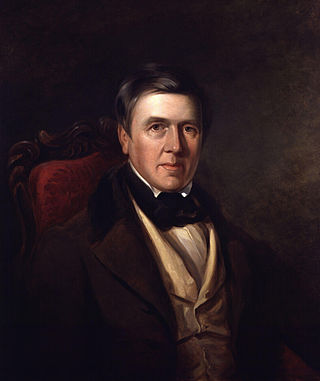
David Cox was an English landscape painter, one of the most important members of the Birmingham School of landscape artists and an early precursor of Impressionism.

William Powell Frith was an English painter specialising in genre subjects and panoramic narrative works of life in the Victorian era. He was elected to the Royal Academy in 1853, presenting The Sleeping Model as his Diploma work. He has been described as the "greatest British painter of the social scene since Hogarth".
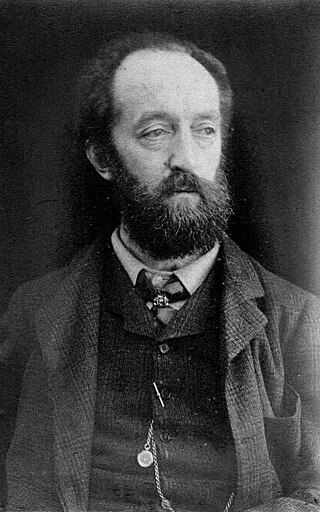
Henry Holiday was an English Victorian painter of historical genre and landscapes, also a stained-glass designer, illustrator, and sculptor. He was influenced by the Pre-Raphaelite Brotherhood, many of whom he knew.
Thomas Seddon was an English landscape painter associated with the Pre-Raphaelite movement, who painted colourful and highly detailed scenes of Brittany, Egypt, and Jerusalem.
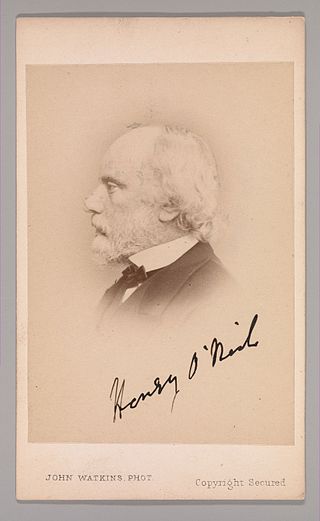
Henry Nelson O'Neil was a historical genre painter and minor Victorian writer. He worked primarily with historical and literary subjects, but his best-known paintings dealt with the Indian Mutiny. Eastward, Ho!, dated August 1857 but exhibited the following year, depicts the British troops embarking for India. A second painting, Home Again (1859), shows the troops returning to England. He also had popular successes with romantic scenes portraying the deaths of Mozart and Raphael, depicted as though mentally transported to heaven by their own religious art. In The Last Moments of Mozart the dying composer listens to singers performing part of his Requiem. The Last Moments of Raphael shows the painter contemplating the unseen figure of Christ in his Transfiguration.

The Battle of Trafalgar, 21 October 1805 is an 1822 painting by British artist J. M. W. Turner. It was commissioned by King George IV as a part of a series of works to decorate three state reception rooms in St James's Palace and link the Hanoverian dynasty with military success. This work was Turner's only royal commission, and was to stand as the pendant piece to Philippe-Jacques de Loutherbourg's Lord Howe's action, or the Glorious First of June. This massive history painting measures 2,615 millimetres x 3,685 millimetres and is his largest work. It was given to Greenwich Hospital shortly after its original installation. The painting now hangs in the National Maritime Museum, also in Greenwich, London.

Simeon Solomon was a British painter associated with the Pre-Raphaelites who was noted for his depictions of Jewish life and same-sex desire. His career was cut short as a result of public scandal following his arrests and convictions for attempted sodomy in 1873 and 1874.

Philip Hermogenes Calderon was a British painter of French birth (mother) and Spanish (father) ancestry who initially worked in the Pre-Raphaelite style before moving towards historical genre. He was Keeper of the Royal Academy in London.
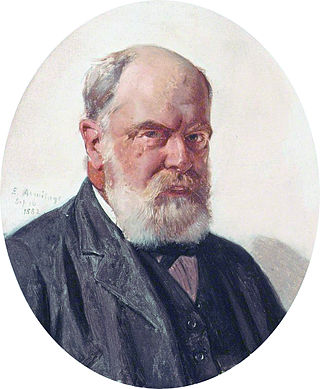
Edward Armitage was an English Victorian-era painter whose work focused on historical, classical and biblical subjects.

John Brett was a British artist associated with the Pre-Raphaelite movement, mainly notable for his highly detailed landscapes.
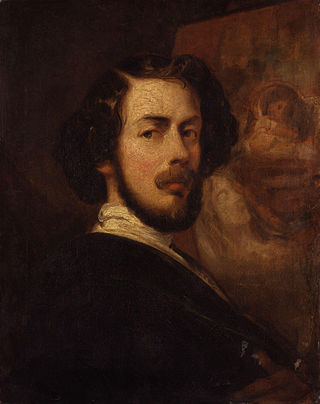
Thomas Jones Barker was an English historical, military, and portrait painter.
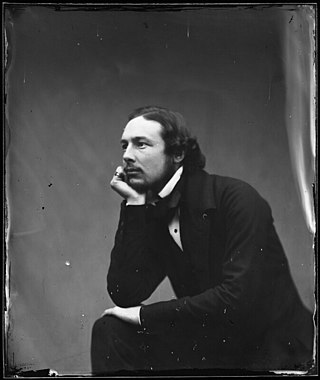
George Price Boyce was a British watercolour painter of landscapes and vernacular architecture in the Pre-Raphaelite style. He was a patron and friend of Dante Gabriel Rossetti.

George Arnald was a British painter who specialised in landscapes, including topographical views to illustrated county histories. He is best known for his celebrated painting depicting the Battle of the Nile.

Robert Howlett was a British pioneering photographer whose pictures are widely exhibited in major galleries. Howlett produced portraits of Crimean War heroes, genre scenes and landscapes. His photographs include the iconic picture of Isambard Kingdom Brunel which was part of a commission by the London-based weekly newspaper Illustrated Times to document the construction of the world's largest steamship, the SS Great Eastern.
Louis William Desanges; Chevalier Desanges (1822–1905) was an English artist of French background, known today for his paintings of Victoria Cross winners.

Pegwell Bay, Kent – a Recollection of October 5th 1858 is an oil-on-canvas painting by British artist William Dyce, depicting the landscape at Pegwell Bay, on the east coast of Kent. Considered a Pre-Raphaelite work, Dyce employs a mode of heightened realism and intricate detail to create a powerful landscape. It is considered to be Dyce's best painting, and is held by the Tate Gallery.
John Collingham Moore was a British artist during the Victorian era. He painted landscapes in Italy before becoming known as a portrait painter upon his return to England.
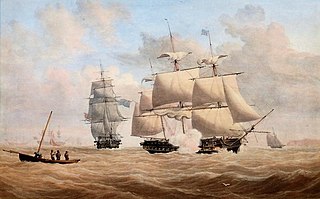
The brothers John Cantiloe Joy, and William Joy, were English marine artists, who lived and worked together. They belonged to the Norwich School of painters, considered to be a unique phenomenon in the history of British art and the most important school of painting of 19th century England.

George Shalders was an English painter and watercolourist.


















